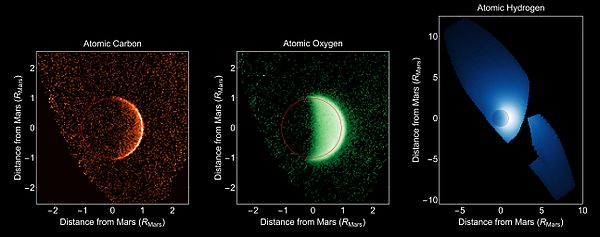MAVEN
 Artist's rendering of the MAVEN spacecraft bus | |
| Names |
|
|---|---|
| Mission type | Mars atmospheric research |
| Operator | NASA |
| COSPAR ID | 2013-063A |
| SATCATno. | 39378 |
| Website | Official website |
| Mission duration | 2 years (planned) Science phase extended indefinitely 9 years, 9 months, 24 days (in progress) |
| Spacecraft properties | |
| Manufacturer | Lockheed Martin Space Systems |
| Launch mass | 2,454 kg (5,410 lb)[1] |
| Dry mass | 809 kg (1,784 lb) |
| Payload mass | 65 kg (143 lb) |
| Dimensions | 2.3 m × 2.3 m × 2 m |
| Power | 1135 watts[2] |
| Start of mission | |
| Launch date | 18 November 2013, 18:28:00UTC |
| Rocket | Atlas V401 (AV-038) |
| Launch site | Cape Canaveral,SLC-41 |
| Contractor | United Launch Alliance |
| Orbital parameters | |
| Reference system | Areocentric orbit |
| Regime | Elliptic orbit |
| Periareon altitude | 150 km (93 mi) |
| Apoareon altitude | 6,200 km (3,900 mi) |
| Inclination | 75° |
| Period | 4.5 hours |
| Marsorbiter | |
| Orbital insertion | 22 September 2014, 02:24 UTC[3] MSD50025 08:07AMT |
 Maven mission logo | |
MAVENis aNASAspacecraft orbitingMarsto study the loss of that planet's atmospheric gases to space, providing insight into the history of the planet's climate and water.[4]The name is an acronym for "Mars Atmosphere and Volatile Evolution"while the wordmavenalso denotes "a person who has special knowledge or experience; an expert".[5][6]MAVEN was launched on anAtlas Vrocket fromCape Canaveral Air Force Station,Florida, on 18 November 2013UTCand went into orbit around Mars on 22 September 2014UTC.The mission is the first byNASAto study the Mars atmosphere. The probe is analyzing the planet's upper atmosphere and ionosphere to examine how and at what rate thesolar windis stripping away volatile compounds.
Theprincipal investigatorfor the mission isShannon Curryat theUniversity of California, Berkeley.She took over fromBruce Jakoskyof theLaboratory for Atmospheric and Space Physicsat theUniversity of Colorado Boulder,who proposed and led the mission until 2021.[4]The project cost $582.5 million to build, launch, and operate through its two-year prime mission.[7]
Pre-launch[edit]
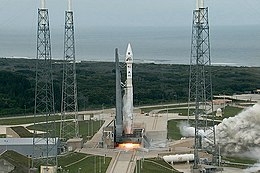
Proposed in 2006, the mission was the second ofNASA'sMars Scout Program,which had previously yieldedPhoenix.It was selected for development for flight in 2008.[8]
On 2 August 2013, the MAVEN spacecraft arrived atKennedy Space Center,inFloridato begin launch preparations.[9]
On 1 October 2013, only seven weeks before launch, agovernment shutdowncaused suspension of work for two days and initially threatened to force a 26-month postponement of the mission. With the spacecraft nominally scheduled to launch on 18 November 2013, a delay beyond 7 December 2013 would have caused MAVEN to miss the launch window asMarsmoved too far out of alignment with theEarth.[10]
However, two days later, on 3 October 2013, a public announcement was made that NASA had deemed the 2013 MAVEN launch so essential to ensuring future communication with current NASA assets on Mars — the roversOpportunityandCuriosity— that emergency funding was authorized to restart spacecraft processing in preparation for an on-time launch.[11]
Objectives[edit]
Features on Mars that resemble dryriverbedsand the discovery ofmineralsthat form in thepresence of waterindicate that Mars once had adense enough atmosphereand was warm enough forliquid waterto flow on the surface. However, that thick atmosphere was somehow lost to space. Scientists suspect that over millions of years, Mars lost 99% of its atmosphere as theplanet's corecooled and its magnetic field decayed, allowing thesolar windto sweep away most of the water and volatile compounds that the atmosphere once contained.[12]
The goal of MAVEN is to determine the history of the loss of atmospheric gases to space, providing answers aboutMartian climateevolution. By measuring the rate with which the atmosphere is currently escaping to space and gathering enough information about the relevant processes, scientists will be able to infer howthe planet's atmosphereevolved over time. The MAVEN mission's primary scientific objectives are:
- Measure the composition and structure of the upper atmosphere and ionosphere today, and determine the processes responsible for controlling them
- Measure the rate of loss of gas from the top of the atmosphere to space, and determine the processes responsible for controlling them
- Determine properties and characteristics that will allow us to extrapolate backwards in time to determine the integrated loss to space over the four-billion-year history recorded in the geological record.[8]
Timeline[edit]
MAVEN launched from theCape Canaveral Air Force Station(CCAFS) on 18 November 2013, using anAtlas V401launch vehicle.[13][14]It reached Mars on 22 September 2014, and was inserted into anelliptic orbitapproximately 6,200 km (3,900 mi) by 150 km (93 mi)above the planet's surface.[14]
In October 2014, as the spacecraft was being fine-tuned to start its primary science mission, thecomet Siding Springwas also performing a close flyby of Mars. The researchers had to maneuver the craft to mitigate harmful effects of the comet, but while doing so, were able to observe the comet and perform measurements on the composition of expelled gases and dust.[15]
On 16 November 2014, investigators completed MAVEN's commissioning activities and began its primary science mission, scheduled to last one year.[16]During that time, MAVEN had observed a nearby comet, measured how volatile gases are swept away by solar wind, and performed four "deep dips" down to the border of the upper and lower atmospheres to better characterize the planet's entire upper atmosphere.[17]In June 2015, the science phase was extended through September 2016, allowing MAVEN to observe the Martian atmosphere through the entirety of the planet's seasons.[18]
On 3 October 2016, MAVEN completed one full Martian year of scientific observations. It had been approved for an additional 2-year extended mission through September 2018. All spacecraft systems were still operating as expected.[19]
In March 2017, MAVEN's investigators had to perform a previously unscheduled maneuver to avoid colliding withPhobosthe following week.[20]
On 5 April 2019, the navigation team completed a two-monthaerobrakingmaneuver to lower MAVEN's orbit and enable it to better serve as a communications relay for current landers as well as the roverPerseverance.This new elliptic orbit is approximately 4,500 km (2,800 mi) by 130 km (81 mi). With 6.6 orbits per Earth day, the lower orbit allows more frequent communication with rovers.[21]
As of September 2020, the spacecraft is continuing its science mission as well, with all instruments still operating and with enough fuel to last at least until 2030.[21]
On August 31, 2021, Shannon Curry became the Principal Investigator of the mission.[22]
NASA became aware of failures in the MAVEN's inertia measurement units (IMU) in late 2021, necessary for the probe to maintain its orbit; having already moved from the main IMU to the backup one in 2017, they saw the backup ones showing signs of failure. In February 2022, both IMUs had appeared to have lost the ability to perform its measurement properly. After doing a heartbeat termination to restore the use of the backup IMU, NASA engineers set to reprogram MAVEN to use an "all stellar" mode using star positions to maintain its altitude, eliminating the reliance on the IMUs. This was put into place in April 2022 and completed by May 28, 2022, but during this period, MAVEN could not be used for scientific observations or to relay communications to Earth from the roversCuriosityandPerseveranceand theInsightlander. Reduced communication was handled by other Mars orbiters.[23]
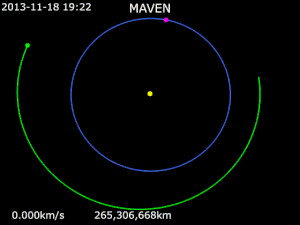
MAVEN·Mars·Earth·Sun
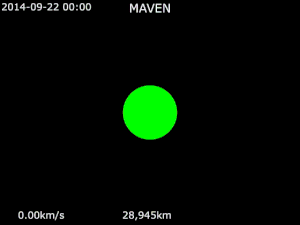 MAVEN·Mars |
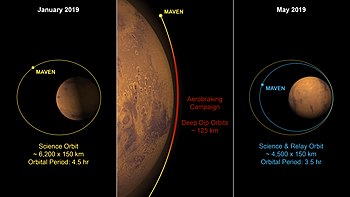 MAVENaerobrakingto a lower orbit – in preparation for theMars 2020 mission(February 2019) |
Spacecraft overview[edit]
MAVEN was built and tested byLockheed Martin Space Systems.Its design is based on those ofMars Reconnaissance Orbiterand2001 Mars Odyssey.The orbiter has a cubical shape of about 2.3 m × 2.3 m × 2 m (7 ft 7 in × 7 ft 7 in × 6 ft 7 in) high,[24]with twosolar arraysthat hold themagnetometerson both ends. The total length is 11.4 m (37 ft).[25]
Relay telecommunications[edit]
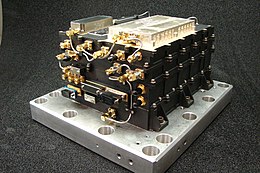
NASA'sJet Propulsion Laboratoryprovided anElectraultra high frequency (UHF) relay radio payload which has a data return rate of up to 2048 kbit/s.[26]The highly elliptical orbit of the MAVEN spacecraft may limit its usefulness as a relay for operating landers on the surface, although the long view periods of MAVEN's orbit have afforded some of the largest relay data returns to date of any Mars orbiter.[27]During the mission's first year of operations at Mars — the primary science phase — MAVEN served as a backup relay orbiter. In the extended mission period of up to ten years, MAVEN will provide UHF relay service for present and future Mars rovers and landers.[18]
Scientific instruments[edit]

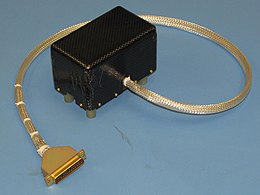

TheUniversity of Colorado Boulder,University of California, Berkeley,andGoddard Space Flight Centereach built a suite of instruments for the spacecraft, and they include:[28]
Built by the University of California, BerkeleySpace Sciences Laboratory:
- Solar Wind Electron Analyzer (SWEA)[29]– measuressolar windand ionosphereelectrons.The goals of SWEA with respect to MAVEN are to deduce magneto-plasma topology in and above the ionosphere, and to measure atmospheric electron impact ionization effects.[30]
- Solar Wind Ion Analyzer (SWIA)[31]– measures solar wind andmagnetosheathion density and velocity. The SWIA therefore characterizes the nature of solar wind interactions within the upper atmosphere.
- SupraThermal And Thermal Ion Composition (STATIC)[32]– measures thermal ions to moderate-energy escaping ions. This provides information on the current ion escape rates from the atmosphere and how rates change during various atmospheric events.
- Solar Energetic Particle (SEP)[33]– determines the impact ofSEPson the upper atmosphere. In context with the rest of this suite, it evaluates how SEP events affect upper atmospheric structure, temperature, dynamics and escape rates.
Built by theUniversity of Colorado BoulderLaboratory for Atmospheric and Space Physics:
- Imaging Ultraviolet Spectrometer (IUVS)[34]– measures global characteristics of the upper atmosphere and ionosphere. The IUVS has separate far-UV and mid-UV channels, a high resolution mode to distinguishdeuteriumfromhydrogen,optimization forairglowstudies, and capabilities that allow complete mapping and nearly continuous operation.[35]
- Langmuir Probe and Waves (LPW)[36]– determines ionosphere properties and wave heating of escaping ions and solarextreme ultraviolet(EUV) input to atmosphere. This instrument provides better characterization of the basic state of the ionosphere and can evaluate the effects of the solar wind on the ionosphere.
Built byGoddard Space Flight Center:
- Magnetometer (MAG)[37]– measures interplanetary solar wind and ionospheremagnetic fields.
- Neutral Gas and Ion Mass Spectrometer (NGIMS)[38]– measures the composition andisotopesofneutral gasesandions.This instrument evaluates how the lower atmosphere can affect higher altitudes while also better characterizing the structure of the upper atmosphere from thehomopauseto theexobase.
SWEA, SWIA, STATIC, SEP, LPW, and MAG are part of the Particles and Fields instrument suite, IUVS is the Remote Sensing instrument suite, and NGIMS is its own eponymous suite.
Cost[edit]
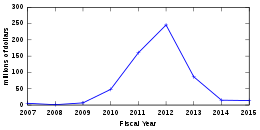
MAVEN cost US$582.5 million to build, launch, and operate for its prime mission, nearly US$100 million less than originally estimated. Of this total, US$366.8 million was for development, US$187 million for launch services, and US$35 million was for the 2-year prime mission. On average, NASA spends US$20 million annually on MAVEN's extended operations.[7]
Results[edit]
Atmospheric loss[edit]
Mars loses water into its thin atmosphere by evaporation. There, solar radiation can split the water molecules into their components,hydrogenandoxygen.The hydrogen, as the lightest element, then tends to rise far up to the highest levels of theMartian atmosphere,where several processes can strip it away into space, to be forever lost to the planet. This loss was thought to proceed at a fairly constant rate, but MAVEN's observations of Mars's atmospheric hydrogen through a full Martian year (almost two Earth years) show that the escape rate is highest when Mars's orbit brings it closest to theSun,and only one-tenth as great when it is at its farthest.[39]
On 5 November 2015,NASAannounced that data from MAVEN shows that the deterioration of Mars's atmosphere increases significantly duringsolar storms.That loss of atmosphere to space likely played a key role in Mars's gradual shift from itscarbon dioxide–dominated atmosphere – which had kept Mars relatively warm and allowed the planet to support liquid surface water – to the cold, arid planet seen today. This shift took place between about 4.2 and 3.7 billion years ago.[40]Atmospheric loss was especially notable during an interplanetarycoronal mass ejectionin March 2015.[41]
Different types of aurora[edit]
In 2014, MAVEN researchers detected widespreadaurorathroughout the planet, even close to the equator. Given the localized magnetic fields on Mars (as opposed to Earth's global magnetic field), aurora appear to form and distribute in different ways on Mars, creating what scientists call diffuse aurora. Researchers determined that the source of the particles causing the aurorae were a huge surge of electrons originating from the Sun. These highly energetic particles were able to penetrate far deeper into Mars's atmosphere than they would have on Earth, creating aurora much closer to the surface of the planet (~60 km as opposed to 100–500 km on Earth).[43]
Scientists also discovered proton aurora, different from the so-called typical aurora which is produced by electrons. Proton aurora were previously only detected on Earth.[44]
Interaction with a comet[edit]
The fortuitous arrival of MAVEN just before a flyby of the comet Siding Spring gave researchers a unique opportunity to observe both the comet itself as well as its interactions with the Martian atmosphere. The spacecraft's IUVS instrument detected intense ultraviolet emissions from magnesium and iron ions, a result from the comet's meteor shower, which were much stronger than anything ever detected on Earth.[45]The NGIMS instrument was able to directly sample dust from thisOort Cloudcomet, detecting at least eight different types of metal ions.[46]
Detection of metal ions[edit]
In 2017, results were published detailing the detection of metal ions in Mars's ionosphere. This is the first time metal ions have been detected in any planet's atmosphere other than Earth's. It was also noted that these ions behave and are distributed differently in the atmosphere of Mars given that the red planet has a much weaker magnetic field than our own.[47]
Impacts on future exploration[edit]
In September 2017, NASA reported a temporary doubling ofradiation levelson the surface of Mars, as well as anaurora25 times brighter than any observed earlier. This occurred due to a massive, and unexpected,solar storm.[48]The observation provided insight into how changes in radiation levels might impact the planet's habitability, helping NASA researchers understand how to predict as well as mitigate effects on future human Mars explorers.
See also[edit]
- Atmosphere of Mars– Layer of gases surrounding the planet Mars
- Trace Gas Orbiter– Mars orbiter, part of ExoMars programme
- Exploration of Mars
- List of Mars orbiters– List of spacecraft orbiting the planet Mars
- List of missions to Mars
- Mars Express– European Mars orbiter
- Mars Global Surveyor– NASA orbiter mission to Mars (1996–2006)
- Mars MetNet– Planned science mission to Mars featuring semi-hard landing strategy
- Mars Exploration Program– Uncrewed spaceflight program by NASA
- Mars Orbiter Mission– Indian space probe, launched in 2013
- New Frontiers program– Series of space exploration missions being conducted by NASA
- Sandra Cauffman– Costa Rican physicist and electrical engineer
- Space weather– Branch of space physics and aeronomy
References[edit]
- ^"MAVEN".NASA's Solar System Exploration website.Retrieved1 December2022.
- ^'MAVEN' Mission PowerPoint
 This article incorporates text from this source, which is in thepublic domain.
This article incorporates text from this source, which is in thepublic domain.
- ^Brown, Dwayne; Neal-Jones, Nancy; Zubritsky, Elizabeth (21 September 2014)."NASA's Newest Mars Mission Spacecraft Enters Orbit around Red Planet".NASA.Retrieved22 September2014.
 This article incorporates text from this source, which is in thepublic domain.
This article incorporates text from this source, which is in thepublic domain.
- ^ab"MAVEN Fact Sheet"(PDF).
 This article incorporates text from this source, which is in thepublic domain.
This article incorporates text from this source, which is in thepublic domain.
- ^@maven2mars (28 October 2013)."Fittingly, from #Hebrew, via #Yiddish, a" maven "is a trusted expert who understands and seeks to pass knowledge on to others. #MAVEN #Mars"(Tweet).Retrieved7 March2015– viaTwitter.
- ^American Heritage Dictionary of the English Language(4th ed.). Boston: Houghton Mifflin. 2000. p.1082.ISBN0-395-82517-2.Retrieved7 March2015.
A person who has special knowledge or experience; an expert.
- ^ab"The Planetary Exploration Budget Dataset".planetary.org.The Planetary Society.Retrieved2 November2020.
- ^abJakosky, B. M.; Lin, R. P.; Grebowsky, J. M.; Luhmann, J. G.; Mitchell, D. F.; Beutelschies, G.; Priser, T.; Acuna, M.; Andersson, L.; Baird, D.; Baker, D. (December 2015)."The Mars Atmosphere and Volatile Evolution (MAVEN) Mission".Space Science Reviews.195(1–4): 3–48.Bibcode:2015SSRv..195....3J.doi:10.1007/s11214-015-0139-x.ISSN0038-6308.S2CID18698391.
- ^"NASA Begins Launch Preparations for Next Mars Mission".NASA. 5 August 2013.Retrieved6 August2013.
 This article incorporates text from this source, which is in thepublic domain.
This article incorporates text from this source, which is in thepublic domain.
- ^Dreier, Casey (30 September 2013)."A Government Shutdown Could Delay MAVEN's Launch to Mars".The Planetary Society.Retrieved11 December2022.
- ^Jakosky, Bruce (20 September 2013)."MAVEN reactivation status update".Laboratory of Atmospheric and Space Physics.Retrieved4 October2013.
- ^MAVEN Mission to Investigate How Sun Steals Martian AtmosphereBy Bill Steigerwald (October 5, 2010)
 This article incorporates text from this source, which is in thepublic domain.
This article incorporates text from this source, which is in thepublic domain.
- ^"MAVEN PressKit"(PDF).
- ^ab"MAVEN Science Orbit".Retrieved18 September2020.
- ^mars.nasa.gov."NASA's MAVEN Studies Passing Comet and Its Effects".NASA's Mars Exploration Program.Retrieved18 September2020.
 This article incorporates text from this source, which is in thepublic domain.
This article incorporates text from this source, which is in thepublic domain.
- ^mars.nasa.gov."MAVEN Completes Commissioning And Begins Its Primary Science Mission".NASA's Mars Exploration Program.Retrieved18 September2020.
 This article incorporates text from this source, which is in thepublic domain.
This article incorporates text from this source, which is in thepublic domain.
- ^mars.nasa.gov."NASA's MAVEN Celebrates One Year at Mars".NASA's Mars Exploration Program.Retrieved18 September2020.
 This article incorporates text from this source, which is in thepublic domain.
This article incorporates text from this source, which is in thepublic domain.
- ^abMAVEN – FAQ
- ^"MAVEN Celebrates One Mars Year of Science".3 October 2016.Retrieved25 September2020.
- ^"MAVEN Steers Clear of Mars Moon Phobos".2 March 2017.Retrieved25 September2020.
- ^ab"MAVEN Uses Red Planet's Atmosphere to Change Orbit".5 April 2019.Retrieved25 September2020.
- ^Gran, Rani (9 September 2021)."NASA Mars Mission Begins a New Chapter of Science With a New Leader".
- ^Bartels, Meghan (1 June 2022)."NASA's Mars MAVEN spacecraft spent 3 months on the brink of disaster".Space.Retrieved2 June2022.
- ^MAVEN Mission Primary Structure CompleteNASA(26 September 2011)
 This article incorporates text from this source, which is in thepublic domain.
This article incorporates text from this source, which is in thepublic domain.
- ^MAVEN – Facts
 This article incorporates text from this source, which is in thepublic domain.
This article incorporates text from this source, which is in thepublic domain.
- ^"The Electra Proximity Link Payload for Mars Relay Telecommunications and Navigation"(PDF).NASA. 29 September 2003. Archived fromthe original(PDF)on 2 May 2013.Retrieved11 January2013.
 This article incorporates text from this source, which is in thepublic domain.
This article incorporates text from this source, which is in thepublic domain.
- ^Newest NASA Mars Orbiter Demonstrates Relay ProwessNASA 10 November 2014
 This article incorporates text from this source, which is in thepublic domain.
This article incorporates text from this source, which is in thepublic domain.
- ^"MAVEN – Instruments".University of Colorado Boulder. 2012.Retrieved25 October2012.
- ^Mitchell, D. L.; Mazelle, C.; Sauvaud, J.-A.; Thocaven, J.-J.; Rouzaud, J.; Fedorov, A.; Rouger, P.; Toublanc, D.; Taylor, E.; Gordon, D.; Robinson, M. (1 April 2016)."Solar Wind Electron Analyzer for MAVEN".Space Science Reviews.200(1): 495–528.doi:10.1007/s11214-015-0232-1.ISSN1572-9672.S2CID14670274.
- ^"Solar Wind Electron Analyzer (SWEA)".Retrieved2 October2020.
- ^Halekas, J. S.; Taylor, E. R.; Dalton, G.; Johnson, G.; Curtis, D. W.; McFadden, J. P.; Mitchell, D. L.; Lin, R. P.; Jakosky, B. M. (1 December 2015)."Solar Wind Ion Analyzer for MAVEN".Space Science Reviews.195(1): 125–151.Bibcode:2015SSRv..195..125H.doi:10.1007/s11214-013-0029-z.ISSN1572-9672.S2CID16917187.
- ^McFadden, J. P.; Kortmann, O.; Curtis, D.; Dalton, G.; Johnson, G.; Abiad, R.; Sterling, R.; Hatch, K.; Berg, P.; Tiu, C.; Gordon, D. (1 December 2015)."SupraThermal and Thermal Ion Composition (STATIC) Instrument for MAVEN".Space Science Reviews.195(1): 199–256.doi:10.1007/s11214-015-0175-6.ISSN1572-9672.
- ^Larson, Davin E.; Lillis, Robert J.; Lee, Christina O.; Dunn, Patrick A.; Hatch, Kenneth; Robinson, Miles; Glaser, David; Chen, Jianxin; Curtis, David; Tiu, Christopher; Lin, Robert P. (1 December 2015)."Solar Energetic Particle Investigation for MAVEN".Space Science Reviews.195(1): 153–172.doi:10.1007/s11214-015-0218-z.ISSN1572-9672.S2CID122683322.
- ^McClintock, William E.; Schneider, Nicholas M.; Holsclaw, Gregory M.; Clarke, John T.; Hoskins, Alan C.; Stewart, Ian; Montmessin, Franck; Yelle, Roger V.; Deighan, Justin (1 December 2015)."Imaging Ultraviolet Spectrograph (IUVS) for MAVEN".Space Science Reviews.195(1): 75–124.doi:10.1007/s11214-014-0098-7.ISSN1572-9672.S2CID18008947.
- ^"IUVS for MAVEN".Retrieved12 October2020.
- ^Andersson, L.; Ergun, R. E.; Delory, G. T.; Eriksson, A.; Westfall, J.; Reed, H.; McCauly, J.; Summers, D.; Meyers, D. (1 December 2015)."Langmuir Probe and Waves (LPW) instrument for MAVEN".Space Science Reviews.195(1): 173–198.Bibcode:2015SSRv..195..173A.doi:10.1007/s11214-015-0194-3.ISSN1572-9672.S2CID119556488.
- ^Connerney, J. E. P.; Espley, J.; Lawton, P.; Murphy, S.; Odom, J.; Oliversen, R.; Sheppard, D. (1 December 2015)."MAVEN Magnetic Field Investigation".Space Science Reviews.195(1): 257–291.Bibcode:2015SSRv..195..257C.doi:10.1007/s11214-015-0169-4.ISSN1572-9672.
- ^Mahaffy, Paul R.; Benna, Mehdi; King, Todd; Harpold, Daniel N.; Arvey, Robert; Barciniak, Michael; Bendt, Mirl; Carrigan, Daniel; Errigo, Therese; Holmes, Vincent; Johnson, Christopher S. (1 December 2015)."Neutral Gas and Ion Mass Spectrometer for MARVEN".Space Science Reviews.195(1): 49–73.doi:10.1007/s11214-014-0091-1.ISSN1572-9672.
- ^Jakosky, Bruce M.; Grebowsky, Joseph M.; Luhmann, Janet G.; Brain, David A. (2015)."Initial results from the MAVEN mission to Mars".Geophysical Research Letters.42(21): 8791–8802.Bibcode:2015GeoRL..42.8791J.doi:10.1002/2015GL065271.ISSN1944-8007.
- ^Northon, Karen (5 November 2015)."NASA Mission Reveals Speed of Solar Wind Stripping Martian Atmosphere".NASA.Retrieved5 November2015.
 This article incorporates text from this source, which is in thepublic domain.
This article incorporates text from this source, which is in thepublic domain.
- ^Jakosky, B. M.; Grebowsky, J. M.; Luhmann, J. G.; Connerney, J.; Eparvier, F.; Ergun, R.; Halekas, J.; Larson, D.; Mahaffy, P.; McFadden, J.; Mitchell, D. L. (6 November 2015)."MAVEN observations of the response of Mars to an interplanetary coronal mass ejection".Science.350(6261): aad0210.Bibcode:2015Sci...350.0210J.doi:10.1126/science.aad0210.ISSN0036-8075.PMID26542576.S2CID2876558.
- ^Jones, Nancy; Steigerwald, Bill; Brown, Dwayne; Webster, Guy (14 October 2014)."NASA Mission Provides Its First Look at Martian Upper Atmosphere".NASA.Retrieved15 October2014.
 This article incorporates text from this source, which is in thepublic domain.
This article incorporates text from this source, which is in thepublic domain.
- ^Schneider, N. M.; Deighan, J. I.; Jain, S. K.; Stiepen, A.; Stewart, A. I. F.; Larson, D.; Mitchell, D. L.; Mazelle, C.; Lee, C. O.; Lillis, R. J.; Evans, J. S. (6 November 2015)."Discovery of diffuse aurora on Mars".Science.350(6261): aad0313.Bibcode:2015Sci...350.0313S.doi:10.1126/science.aad0313.hdl:2268/180453.ISSN0036-8075.PMID26542577.S2CID7043426.
- ^Deighan, J.; Jain, S. K.; Chaffin, M. S.; Fang, X.; Halekas, J. S.; Clarke, J. T.; Schneider, N. M.; Stewart, A. I. F.; Chaufray, J.-Y.; Evans, J. S.; Stevens, M. H. (October 2018)."Discovery of a proton aurora at Mars".Nature.2(10): 802–807.Bibcode:2018NatAs...2..802D.doi:10.1038/s41550-018-0538-5.ISSN2397-3366.S2CID105560692.
- ^Schneider, N. M.; Deighan, J. I.; Stewart, A. I. F.; McClintock, W. E.; Jain, S. K.; Chaffin, M. S.; Stiepen, A.; Crismani, M.;Plane, J. M. C.;Carrillo‐Sánchez, J. D.; Evans, J. S. (2015)."MAVEN IUVS observations of the aftermath of the Comet Siding Spring meteor shower on Mars".Geophysical Research Letters.42(12): 4755–4761.Bibcode:2015GeoRL..42.4755S.doi:10.1002/2015GL063863.ISSN1944-8007.
- ^Benna, M.; Mahaffy, P. R.; Grebowsky, J. M.;Plane, J. M. C.;Yelle, R. V.; Jakosky, B. M. (2015)."Metallic ions in the upper atmosphere of Mars from the passage of comet C/2013 A1 (Siding Spring)".Geophysical Research Letters.42(12): 4670–4675.Bibcode:2015GeoRL..42.4670B.doi:10.1002/2015GL064159.ISSN1944-8007.
- ^Grebowsky, J. M.; Benna, M.; Plane, J. M. C.; Collinson, G. A.; Mahaffy, P. R.; Jakosky, B. M. (2017)."Unique, non-Earthlike, meteoritic ion behavior in upper atmosphere of Mars".Geophysical Research Letters.44(7): 3066–3072.Bibcode:2017GeoRL..44.3066G.doi:10.1002/2017GL072635.ISSN1944-8007.
- ^Scott, Jim (30 September 2017)."Large solar storm sparks global aurora and doubles radiation levels on the martian surface".phys.org.Retrieved30 September2017.

